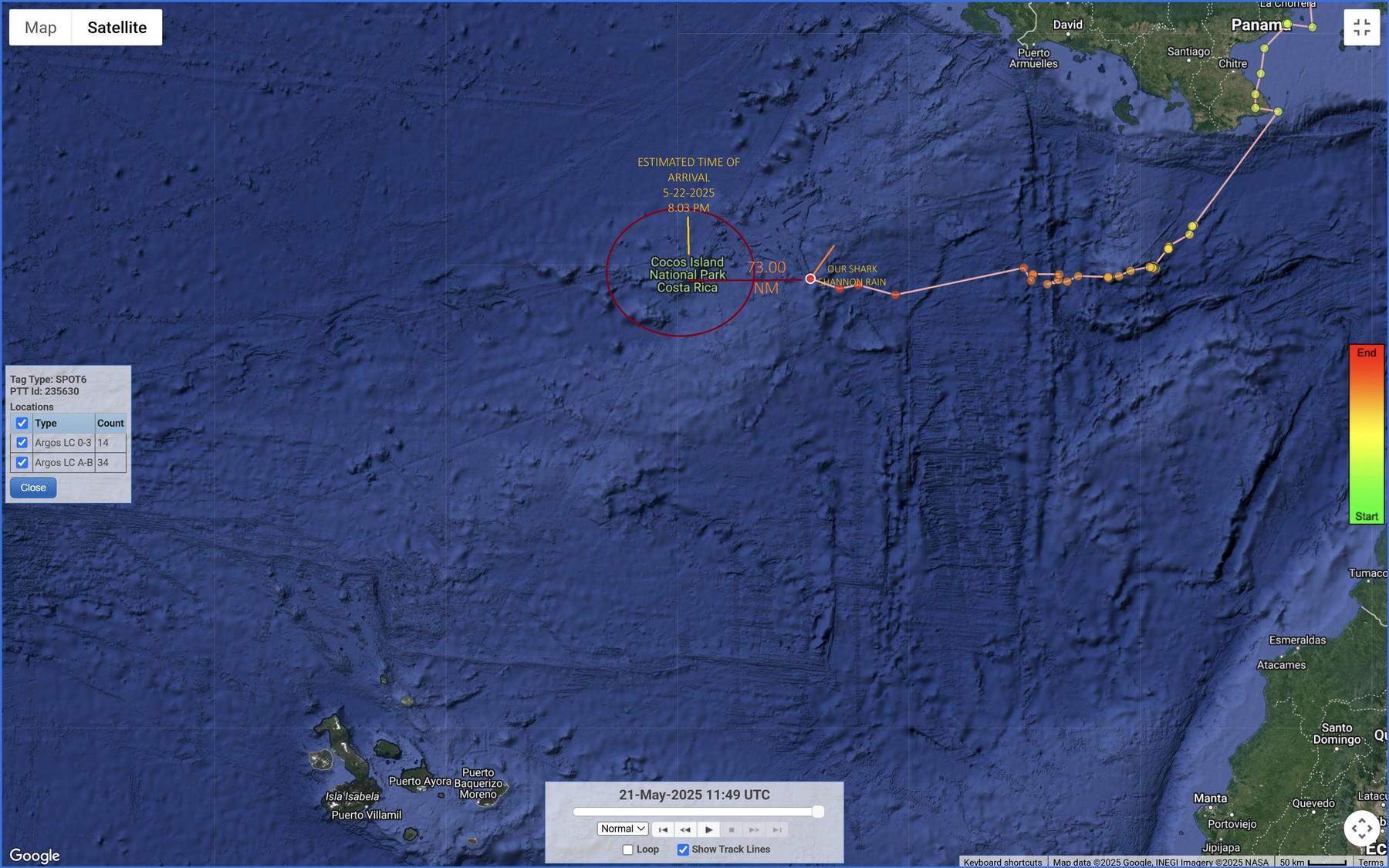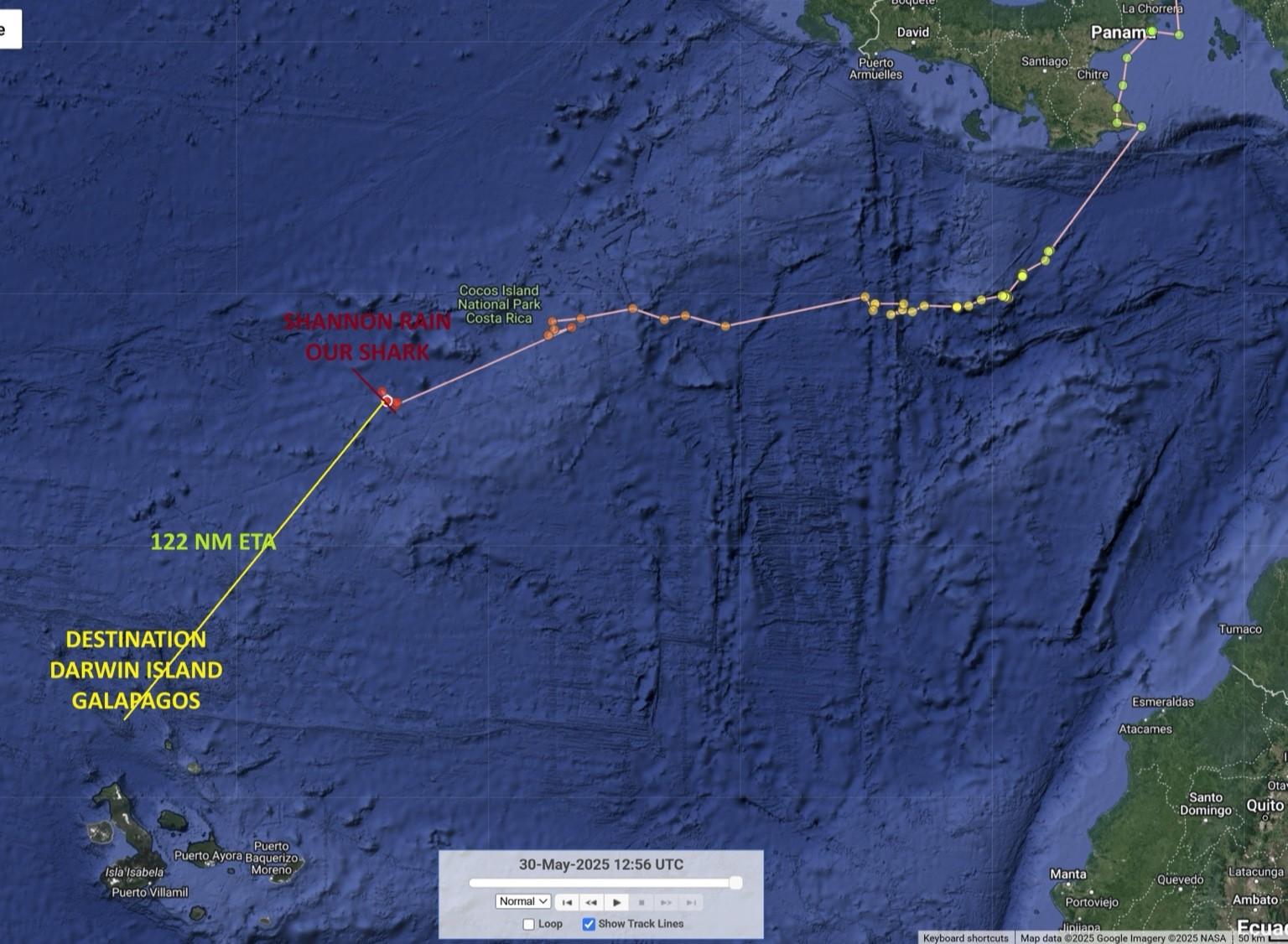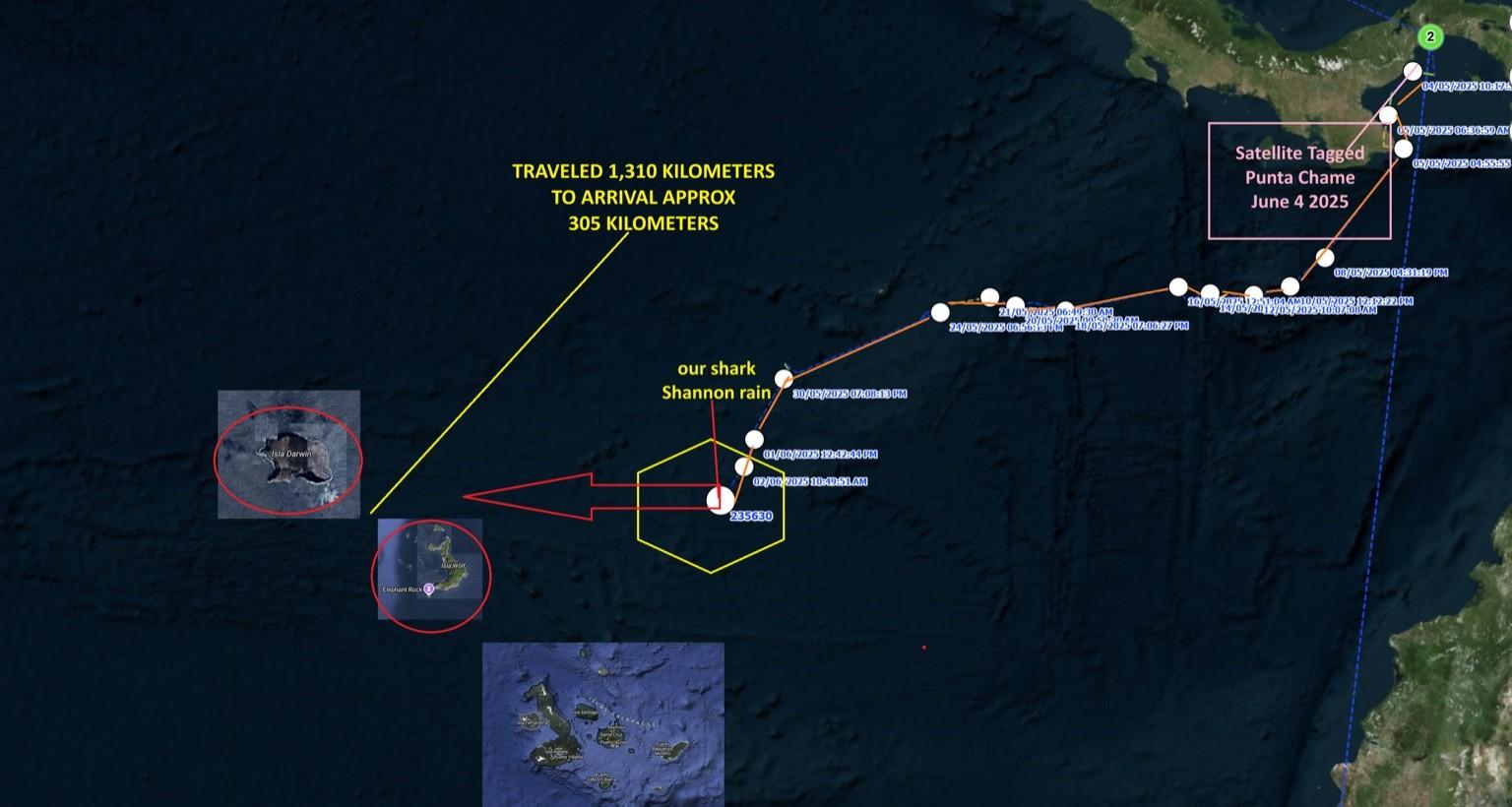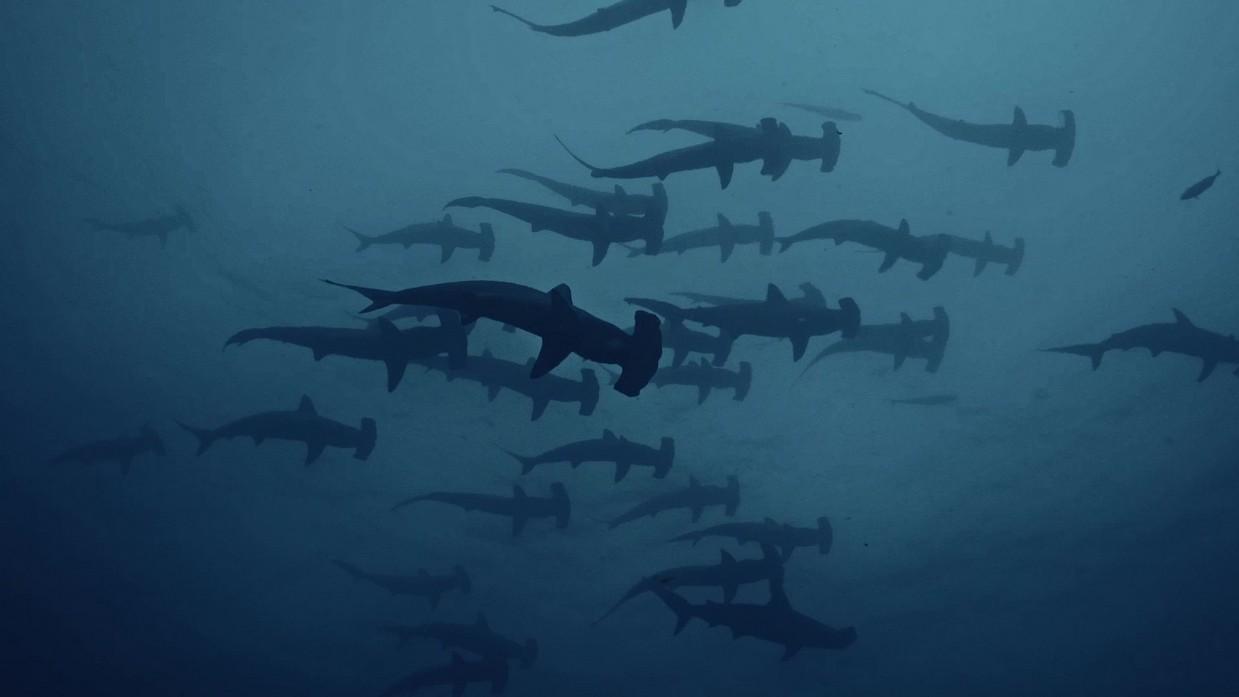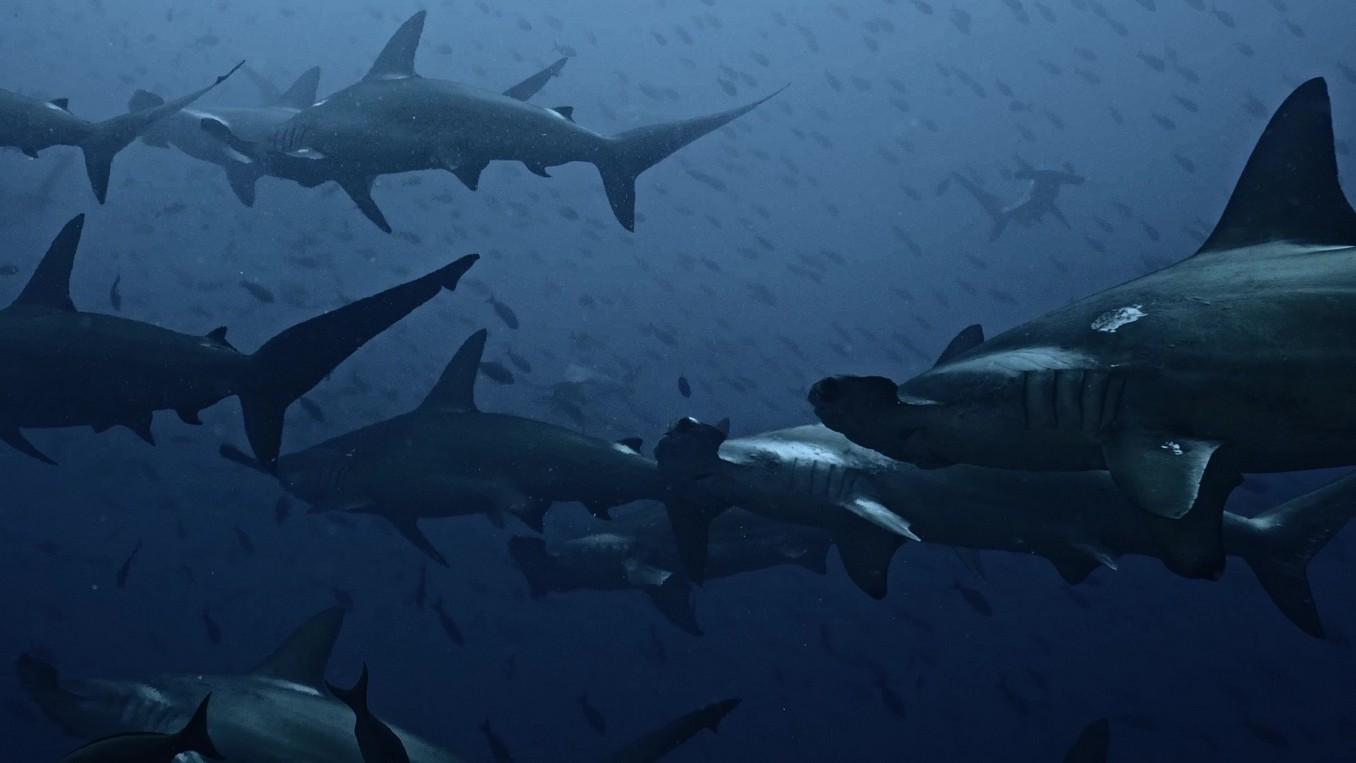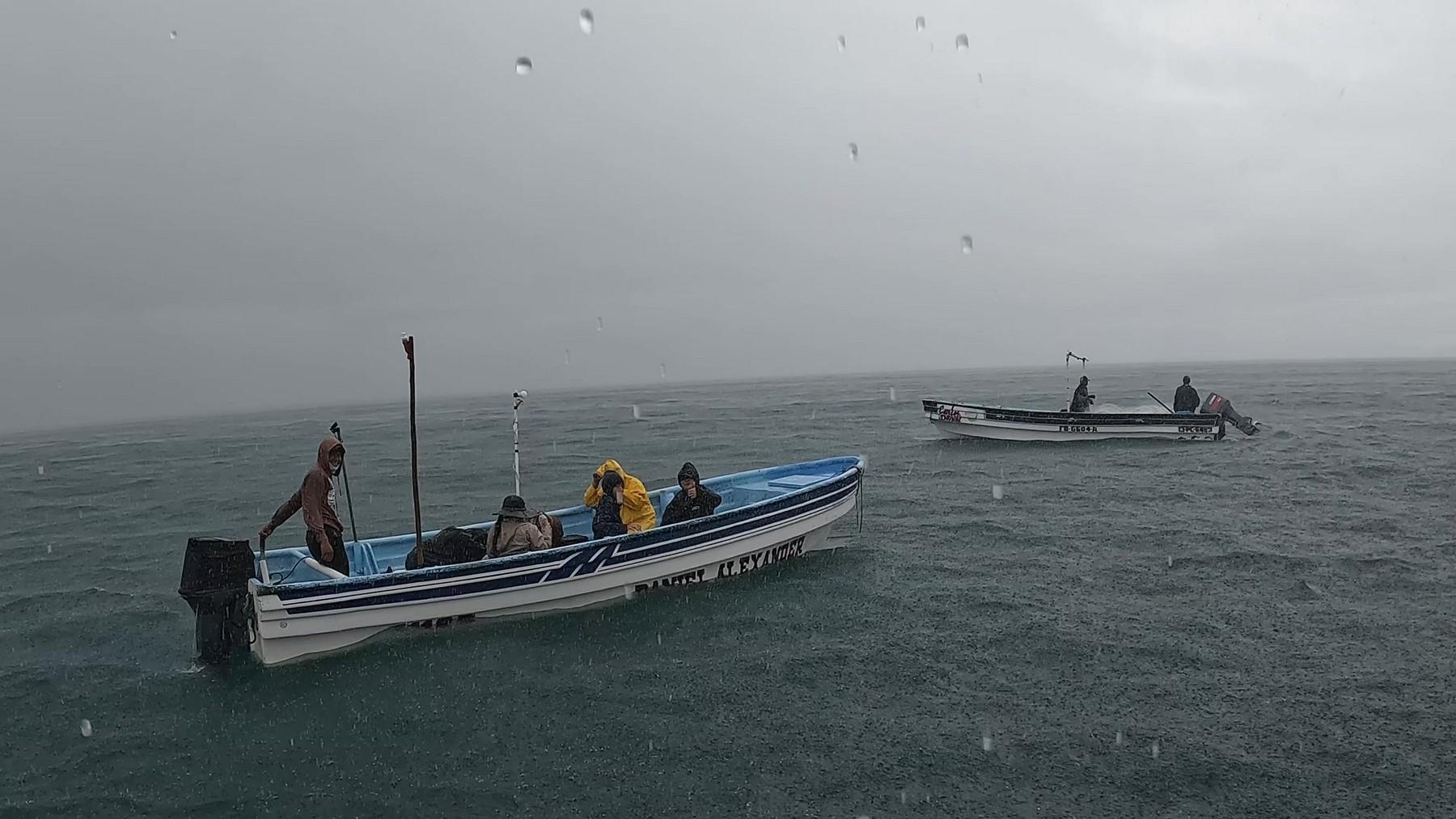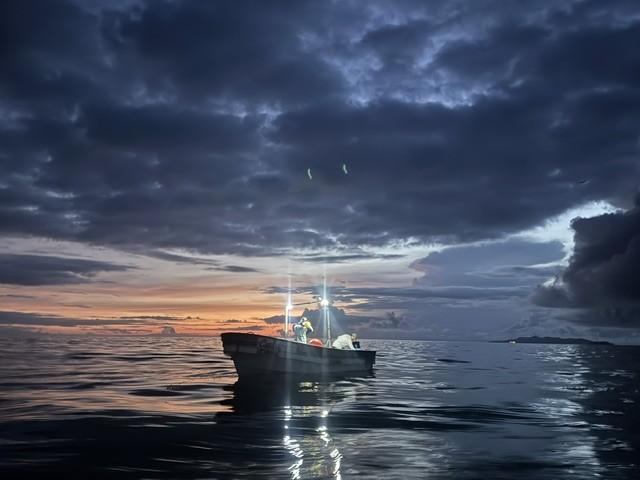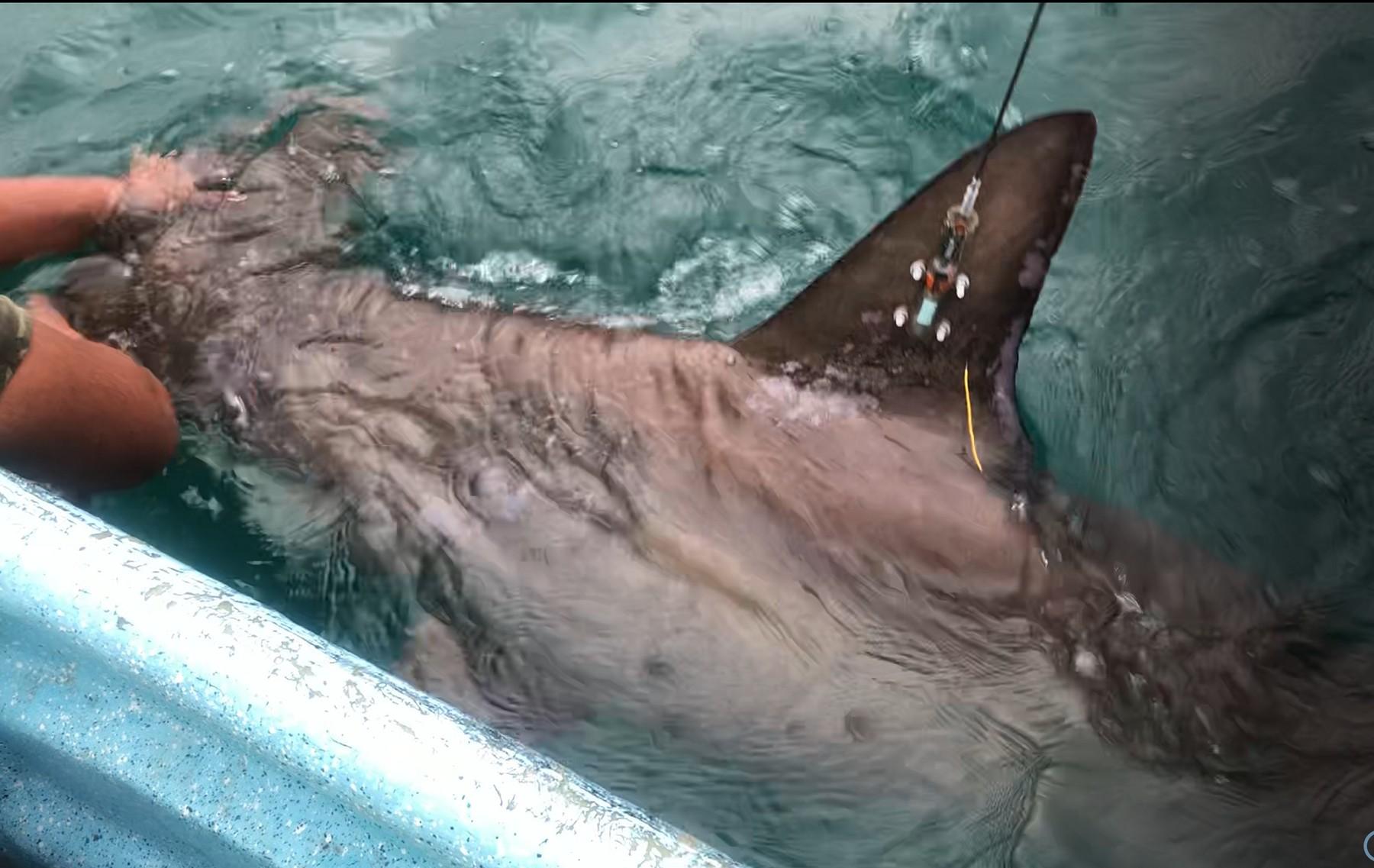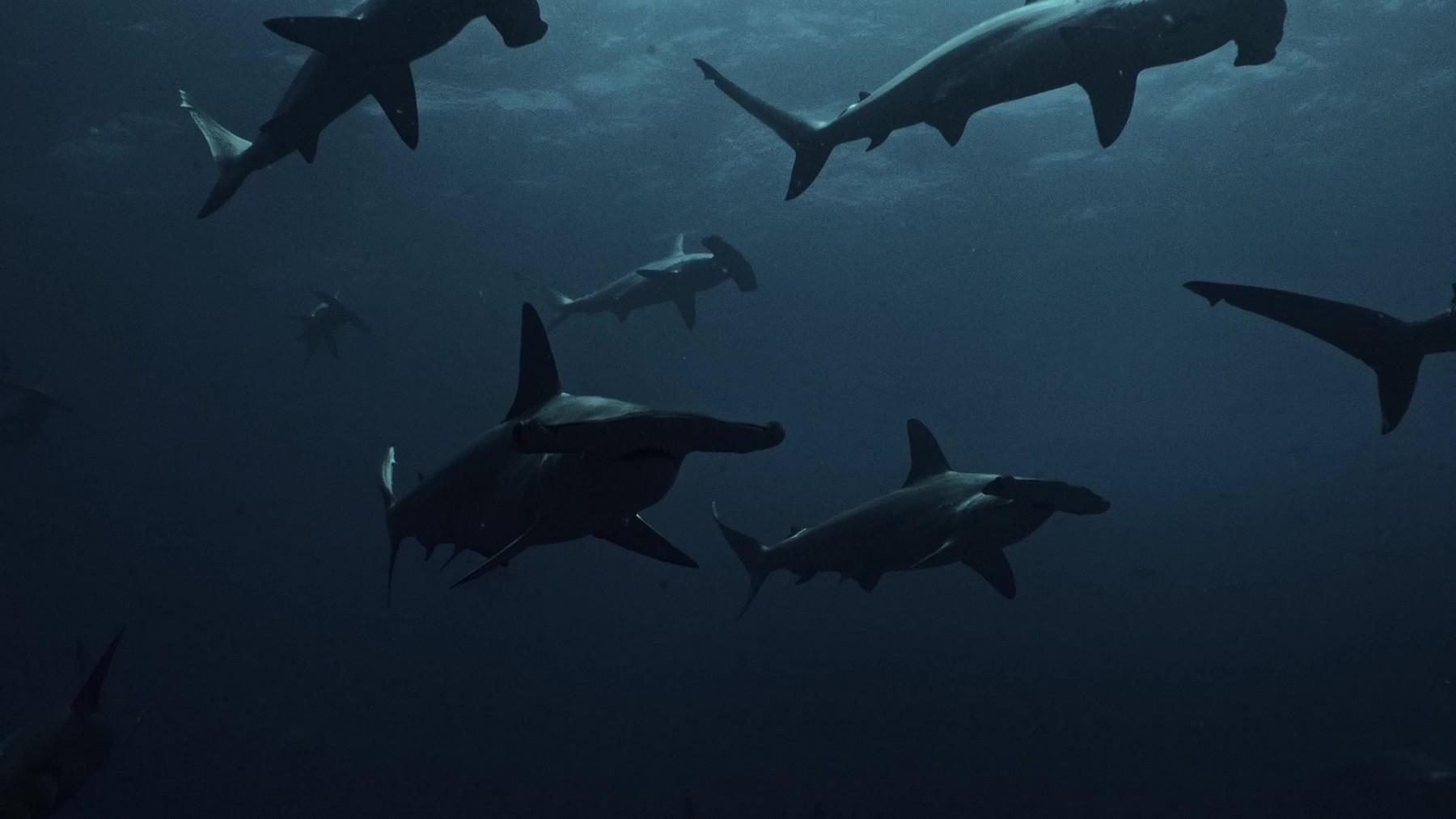Satellite Tagging and Panama Migration Study of the Eastern Pacific Scalloped Hammerhead Sharks (Sphyrna lewini)
Three Years of Research and Dedication
Three years ago, Twin Oceans Research Foundation with the support and collaboration of TCRS The Center for Responsible Seafood, initiated a bold and ambitious program to study the migratory patterns of the scalloped hammerhead shark (Sphyrna lewini), with the goal of satellite tagging an individual making the journey from Panama to the Galápagos Islands. This effort aimed to provide definitive, science-based data to support marine conservation and policy reform in the Eastern Tropical Pacific.
The road to success was anything but easy. We faced years of trial and error— experimenting with bait types, adjusting our techniques to minimize harm, and learning how to identify the precise timing of the migration based on ocean temperatures and seasonal patterns. Early attempts were often met with frustration: arriving too late or too early in the season, losing sharks during capture attempts, or failing to keep them at the surface safely.
Not all was in vain, however. During this period, we successfully applied custom ID tags to over 100 juvenile scalloped hammerhead sharks (Sphyrna lewini). One remarkable case involved a juvenile shark that migrated nearly 90 kilometers off the coast, an unexpected discovery that challenged previous assumptions about early movement patterns from birthing grounds. Although that individual was eventually caught by a fisherman, the tag was identified and reported back to us. This event provided valuable insight and confirmed that even juvenile hammerheads begin dispersal sooner than previously believed. These outcomes became part of our learning curve, and DNA samples collected from these juveniles were stored for future research.
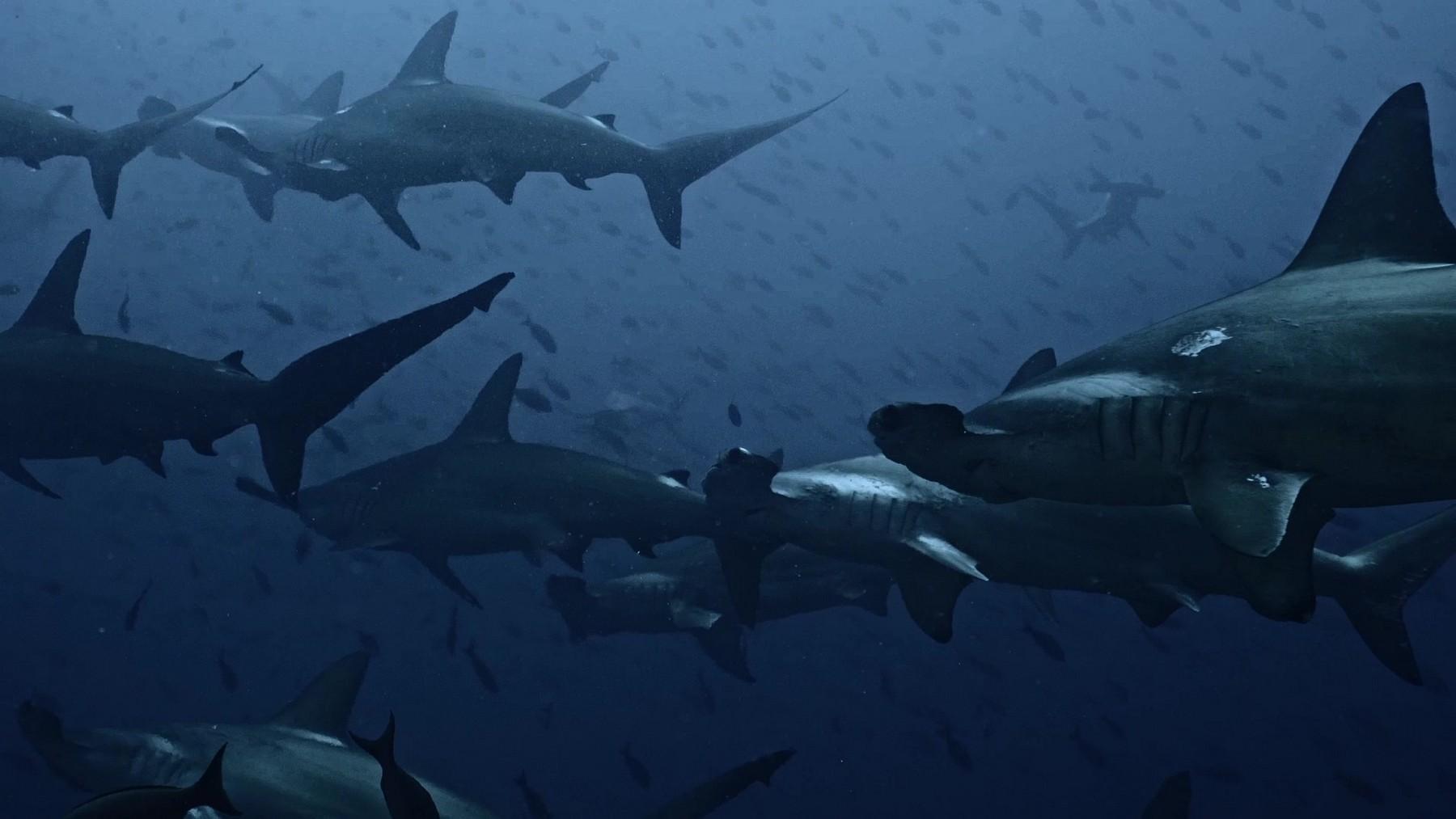
A turning point came in 2024 when we encountered three mature female adult (Sphyrna lewini) scalloped hammerheads at once. Although we were unable to satellite tag them due to safety concerns, we did apply ID tags and gained valuable insight into the physical handling and restraint needed for success.
All of this learning came together in May 2025. After three consecutive nights of effort— in pouring rain and with the dedication of our young marine biologists and volunteers from Shark Defenders—we finally succeeded. At dawn on May 4, 2025, we safely captured, and satellite tagged a healthy mature female adult scalloped hammerhead. We named her Shannon Rain—in honor of the rain-soaked nights that led to this breakthrough.
The following sections of this report will detail Shannon Rain’s journey through the Eastern Pacific, the satellite data collected to date, and what it tells us about this critical migratory corridor.
Methodology: Trial, Error, and Innovation in the Field
The project’s success was built on years of field experimentation, adapting traditional tagging approaches to the unique challenges of scalloped hammerhead sharks in Panamanian waters. From the outset, our primary concern was to develop a non-lethal, minimally invasive capture and tagging process for this highly sensitive and endangered species.
Site Selection and Timing:
Tagging efforts were focused in the Gulf of Panama and adjacent Pacific corridors where juvenile and adult Sphyrna lewini are known to transit. Principally in the areas of Punta Chame, Bona and Otoque Islands. Seasonal shifts in water temperature, current flow, and lunar cycles were tracked to determine peak migration windows. Initial years taught us the importance of timing—not just the month, but the specific nights and tides influencing shark presence.
Baiting Strategy:
Various bait types, including live bait and tuna carcasses, were tested over time. Through controlled trials, we determined that oily, high-scent baits worked best to attract migrating hammerheads without also drawing in larger predatory species. The bait was suspended at strategic depths based on observed diving patterns.
Capture Techniques:
Our approach evolved from conventional hook-and-line methods to the use of customfabricated soft nets and long leads that allowed us to gently bring sharks alongside the vessel. Several sharks were caught and released over the three-year study as we refined techniques that prevented gill or fin damage and avoided inducing fatal stress.
Tag Deployment Protocol:
Satellite tags (SPOT 258H model) were selected for their durability, transmission frequency, and proven performance with hammerhead species in other regions. Tags were applied using a applicator when the shark was stabilized at the surface. Veterinarygrade antiseptics were used to prevent infection at the tag site. All procedures were completed in under five minutes to reduce stress.
Team and Collaboration:
This project was led by Twin Oceans Research Foundation with critical volunteer support from Shark Defenders Panama. Our field team consisted of seasoned divers, marine biologists, veterinarians, and youth conservationists—each contributing to a safe and ethical tagging process.
The successful deployment of the satellite tag on Shannon Rain represents the culmination of this methodology—a blend of patience, science, and passion.
Shannon
Rain’s
Migration Journey and Preliminary Data Analysis
On May 4, 2025, after three years of research and development, Twin Oceans Research Foundation successfully satellite tagged a mature female scalloped hammerhead shark in the coastal waters near Chame, Panama. We named her Shannon Rain in honor of the three rain-soaked nights that culminated in her safe tagging.
From the moment the tag was activated, Shannon Rain began transmitting valuable geolocation data via satellite each time she surfaced. This marked the first time a scalloped hammerhead shark had been satellite tracked along this route from Panama into the Eastern Tropical Pacific Corridor.
Key Movement Data (as of June 8, 2025):
- Total Distance Traveled: Over 1,300 kilometers
- Current Position: Approximately 300 kilometers from the northern Galápagos Islands
- Likely Destination: Either Darwin Island or Wolf Island
- Travel Rate: Averaging ~2.5 km per hour during active migration
- Surface Intervals: Multiple uplink transmissions have confirmed consistent surfacing along the migration corridor
Her trajectory has aligned with known but previously unproven theories of seasonal movement through Cocos Ridge and the underwater seamount corridor leading toward the Galápagos. Her location updates show a clear directional path, strengthening the hypothesis that scalloped hammerheads born in or near Panamanian waters are part of a larger migratory population that returns to offshore aggregation and potential mating sites around Darwin and Wolf Islands.
Behavioral Insight:
Shannon Rain’s route suggests a purposeful and uninterrupted migration—likely instinctual, possibly hormonally driven toward breeding grounds. Surface behavior, as indicated by tag uplinks, shows predictable surfacing patterns every 1–2 days, often during early morning or late afternoon hours. This may reflect resting intervals, navigation behavior, or temperature regulation. The shark's movement also coincides with seasonal upwelling patterns and plankton blooms, offering insights into possible ecological drivers of migration.
BREAKTHROUGH IN SHARK MIGRATION RESEARCH
After our initial deployment in Punta Chame, Panama, 38 days ago—and following a 1,600-kilometer migrating swim, tracked through 58 satellite uplinks and Argos location points, our satellite-tagged scalloped hammerhead shark (Sphyrna lewini), Shannon Rain, has arrived in the Galápagos Islands. As of today, June 10th, she is just 4 kilometers off Wolf Island and is expected to move between Wolf and Darwin Islands.
This marks a historic breakthrough: the first documented case of a female scalloped hammerhead migrating from Panama back to the Galápagos. Even more remarkably, Shannon Rain gave birth to approximately 15 pups at the exact moment of tagging on May 4th in the area of Punta Chame. At this time, we were also able to carefully extract DNA samples from a few of the pups before releasing —samples that may help us identify genetic links to adult sharks tagged in future years. This opens the door to longterm research into familial connections and life-cycle patterns of this endangered species. Much remains to be explored in the years ahead.
This milestone is the result of years of hard work and collaboration by the Twin Oceans Research Foundation and Shark Defenders of Panama, and we extend our heartfelt thanks to TCRS – The Center for Responsible Seafood. This research and the progress we’ve made would not have been possible without their support. Our deepest gratitude goes out to them. We look forward to continuous collaboration and working together in the future.
It’s a victory for science, conservation, and Panama’s role in protecting Eastern Pacific shark populations.
Conclusion and Next Steps: Toward Science-Based Shark Conservation Policy
The successful satellite tagging of Shannon Rain marks a groundbreaking achievement not only for Twin Oceans Research Foundation, but for shark conservation efforts throughout the Eastern Tropical Pacific. This initiative confirms, with real-time geolocation data, that scalloped hammerhead sharks (Sphyrna lewini) migrate between coastal Panamanian waters and the Galápagos Islands—validating long-held but unproven migration theories.
This milestone is more than a scientific success. It provides compelling, verifiable evidence that can and should influence national and regional fisheries policies. The protection of critical habitats—such as birthing grounds in mangrove zones and offshore
migration corridors—is now supported by data rather than theory.
Immediate Goals:
1. Expand Tagging Efforts: Deploy additional satellite and acoustic tags on both male and female hammerheads across different age classes to map full migratory cycles and return behaviors.
2. Data Sharing and Scientific Collaboration: Openly share tracking data with regional networks, including MigraMar and marine policy institutions, to enhance cross-border conservation coordination.
3. Policy Advocacy in Panama: Present findings to Panama’s Ministry of Environment and fisheries authorities to advocate for the establishment of seasonal fishing restrictions during known migration periods (e.g., February–July).
4. Education and Public Awareness: Disseminate these findings through schools, social media, and public campaigns to shift perceptions about hammerhead sharks—from fear to respect—and to underscore the importance of protecting them.
5. Monitor Shannon Rain: Continue tracking her location as she enters Galápagos waters and monitor whether she remains for an extended period—potentially confirming reproductive behaviors tied to specific seamounts or islands.
Acknowledgments:
We extend our deepest thanks to the volunteer marine biologists, Shark Defenders Panama, and all those who contributed countless hours—often in harsh conditions—to make this project possible. Your commitment is helping write the next chapter in shark conservation history.
Appendix: Visual Documentation of Shannon Rain's Migration
Map 1: Key Sites in the Eastern Tropical Pacific Migration Corridor
The tracking days when we thought she was going to go for
Cocos Island Costa Rica
Image of when she turned and headed down to the Galapagos Islands
Showing strong surface currents on the final day arriving close to Wolf Island Galapagos
Shannon Rain is deciding on which island to go to!
Arrival at Galapagos Island between Darwin and Wolf June 10, 2025
Map 7: Movement within the Islands of Darwin and Wolf June 11, 2025
Recording tracking movements through June 12, 2025
SHORT VIDEO OF THE RESEARCH TAGGING TRIP May 2025



